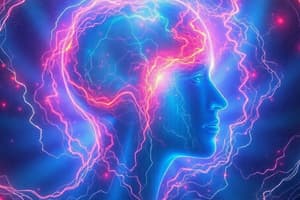Podcast
Questions and Answers
Which of the following best describes reinforcement in operant conditioning?
Which of the following best describes reinforcement in operant conditioning?
- It weakens the probability of an action being repeated.
- It eliminates all forms of behavioral response.
- It strengthens the likelihood of a behavior occurring again. (correct)
- It decreases the likelihood of a behavior occurring again.
What is an example of positive reinforcement?
What is an example of positive reinforcement?
- Giving a child a toy for good behavior. (correct)
- Removing food when hungry.
- Turning off an annoying sound when a task is done.
- Taking away privileges when rules are broken.
Which type of punishment involves adding an unpleasant stimulus?
Which type of punishment involves adding an unpleasant stimulus?
- Positive Punishment (correct)
- Positive Reinforcement
- Negative Reinforcement
- Negative Punishment
What distinguishes primary reinforcers from secondary reinforcers?
What distinguishes primary reinforcers from secondary reinforcers?
According to the Law of Effect, what happens to an action followed by a satisfying consequence?
According to the Law of Effect, what happens to an action followed by a satisfying consequence?
Which of the following is an example of negative reinforcement?
Which of the following is an example of negative reinforcement?
What happens during operant conditioning when a behavior is followed by a punishment?
What happens during operant conditioning when a behavior is followed by a punishment?
Which statement correctly defines a secondary reinforcer?
Which statement correctly defines a secondary reinforcer?
What is an example of a secondary reinforcer?
What is an example of a secondary reinforcer?
In which schedule of reinforcement does reinforcement occur after a variable number of responses?
In which schedule of reinforcement does reinforcement occur after a variable number of responses?
What is the primary goal of shaping in operant conditioning?
What is the primary goal of shaping in operant conditioning?
What does observational learning significantly involve?
What does observational learning significantly involve?
Which of the following schedules of reinforcement occurs after a fixed period of time?
Which of the following schedules of reinforcement occurs after a fixed period of time?
What was the outcome of Albert Bandura's Bobo doll experiment?
What was the outcome of Albert Bandura's Bobo doll experiment?
What is the process of modeling in cognitive-social learning?
What is the process of modeling in cognitive-social learning?
Which statement correctly describes secondary reinforcers?
Which statement correctly describes secondary reinforcers?
What is the first process in Bandura's theory of observational learning?
What is the first process in Bandura's theory of observational learning?
Which of the following best describes 'insight learning'?
Which of the following best describes 'insight learning'?
What is the phenomenon called when a conditioned response reappears after a pause, even after extinction has occurred?
What is the phenomenon called when a conditioned response reappears after a pause, even after extinction has occurred?
What does a cognitive map help us to do?
What does a cognitive map help us to do?
Which statement best describes generalization in conditioning?
Which statement best describes generalization in conditioning?
Which key process involves the observer wanting to imitate a behavior?
Which key process involves the observer wanting to imitate a behavior?
What type of learning remains hidden until it is needed?
What type of learning remains hidden until it is needed?
In the context of classical conditioning, what role does the neutral stimulus play?
In the context of classical conditioning, what role does the neutral stimulus play?
How does discrimination differ from generalization in classical conditioning?
How does discrimination differ from generalization in classical conditioning?
In Bandura's theory, why is attention important?
In Bandura's theory, why is attention important?
What did Tolman's studies with rats help illustrate?
What did Tolman's studies with rats help illustrate?
What is the conditioned response in the example of smartphone notifications?
What is the conditioned response in the example of smartphone notifications?
Which of the following describes 'retention' in observational learning?
Which of the following describes 'retention' in observational learning?
Which of the following best exemplifies Watson's concept of Conditioned Emotional Response (CER)?
Which of the following best exemplifies Watson's concept of Conditioned Emotional Response (CER)?
In the example of the alarm bell, what type of stimulus is the alarm sound categorized as?
In the example of the alarm bell, what type of stimulus is the alarm sound categorized as?
What does a conditioned stimulus do in classical conditioning?
What does a conditioned stimulus do in classical conditioning?
What role does neuroplasticity play in learning a new skill?
What role does neuroplasticity play in learning a new skill?
What is an effective studying technique for long-term memory retention?
What is an effective studying technique for long-term memory retention?
How can positive emotions impact learning?
How can positive emotions impact learning?
Which practice can help manage stress and improve learning?
Which practice can help manage stress and improve learning?
What is the primary effect of breaking a bad habit on the brain?
What is the primary effect of breaking a bad habit on the brain?
What did Tolman's rat experiments reveal about learning?
What did Tolman's rat experiments reveal about learning?
Which brain structure is primarily involved in forming new memories?
Which brain structure is primarily involved in forming new memories?
What does neuroplasticity refer to?
What does neuroplasticity refer to?
Which type of memory is used as a temporary holding area for information?
Which type of memory is used as a temporary holding area for information?
Which brain region is crucial for learning motor skills and coordination?
Which brain region is crucial for learning motor skills and coordination?
What characterizes subconscious learning?
What characterizes subconscious learning?
What makes it easier to recall and perform skills in the future?
What makes it easier to recall and perform skills in the future?
Which memory system is specifically used for problem-solving or reasoning tasks?
Which memory system is specifically used for problem-solving or reasoning tasks?
Flashcards
Classical Conditioning
Classical Conditioning
Learning where a neutral stimulus, paired with a natural stimulus, eventually elicits the same response as the natural stimulus.
Spontaneous Recovery
Spontaneous Recovery
The reappearance of a conditioned response after extinction, often temporary and weaker.
Generalization
Generalization
Learning a response to similar stimuli, not just the original.
Discrimination
Discrimination
Signup and view all the flashcards
Conditioned Emotional Response
Conditioned Emotional Response
Signup and view all the flashcards
Neutral Stimulus
Neutral Stimulus
Signup and view all the flashcards
Unconditioned Response
Unconditioned Response
Signup and view all the flashcards
Conditioned Stimulus
Conditioned Stimulus
Signup and view all the flashcards
Operant Conditioning
Operant Conditioning
Signup and view all the flashcards
Law of Effect
Law of Effect
Signup and view all the flashcards
Reinforcement
Reinforcement
Signup and view all the flashcards
Positive Reinforcement
Positive Reinforcement
Signup and view all the flashcards
Punishment
Punishment
Signup and view all the flashcards
Primary Reinforcer
Primary Reinforcer
Signup and view all the flashcards
Observational Learning
Observational Learning
Signup and view all the flashcards
Attention in Observational Learning
Attention in Observational Learning
Signup and view all the flashcards
Retention in Observational Learning
Retention in Observational Learning
Signup and view all the flashcards
Reproduction in Observational Learning
Reproduction in Observational Learning
Signup and view all the flashcards
Motivation in Observational Learning
Motivation in Observational Learning
Signup and view all the flashcards
Insight Learning
Insight Learning
Signup and view all the flashcards
Cognitive Map
Cognitive Map
Signup and view all the flashcards
Latent Learning
Latent Learning
Signup and view all the flashcards
Secondary Reinforcer
Secondary Reinforcer
Signup and view all the flashcards
Fixed Ratio Schedule
Fixed Ratio Schedule
Signup and view all the flashcards
Variable Ratio Schedule
Variable Ratio Schedule
Signup and view all the flashcards
Shaping
Shaping
Signup and view all the flashcards
Cognitive-Social Learning
Cognitive-Social Learning
Signup and view all the flashcards
Modeling
Modeling
Signup and view all the flashcards
Albert Bandura's Bobo Doll Experiment
Albert Bandura's Bobo Doll Experiment
Signup and view all the flashcards
Implicit Learning
Implicit Learning
Signup and view all the flashcards
How does learning affect the brain?
How does learning affect the brain?
Signup and view all the flashcards
What are synapses?
What are synapses?
Signup and view all the flashcards
How does learning affect synapses?
How does learning affect synapses?
Signup and view all the flashcards
What brain regions are involved in learning?
What brain regions are involved in learning?
Signup and view all the flashcards
Types of memory systems
Types of memory systems
Signup and view all the flashcards
What is neuroplasticity?
What is neuroplasticity?
Signup and view all the flashcards
How does neuroplasticity relate to learning?
How does neuroplasticity relate to learning?
Signup and view all the flashcards
Neuroplasticity and Skill Learning
Neuroplasticity and Skill Learning
Signup and view all the flashcards
Neuroplasticity and Habit Change
Neuroplasticity and Habit Change
Signup and view all the flashcards
Spaced Repetition
Spaced Repetition
Signup and view all the flashcards
Emotional Impact on Learning
Emotional Impact on Learning
Signup and view all the flashcards
Mindfulness for Learning
Mindfulness for Learning
Signup and view all the flashcards
Study Notes
Learning Lecture Overview
- Learning is a relatively permanent change in behavior or mental processes resulting from practice or experience
- The lecture covers Classical Conditioning, Operant Conditioning, Cognitive-Social Learning, and The Biology of Learning
Classical Conditioning
- Definition: Learning when a neutral stimulus is paired with an unconditioned stimulus to elicit a conditioned response
- Key Concepts:
- Neutral Stimulus (NS): A stimulus that doesn't naturally bring about the response of interest
- Unconditioned Stimulus (UCS): A stimulus that elicits an unconditioned response (UCR) without previous conditioning
- Unconditioned Response (UCR): An unlearned reaction to an UCS without prior conditioning
- Conditioned Stimulus (CS): A previous NS that, through repeated pairings with an UCS, now causes a conditioned response (CR)
- Conditioned Response (CR): A learned reaction to a CS
Classical Conditioning Process
- Before Conditioning: UCS (e.g., food) → UCR (e.g., salivation); NS (e.g., bell) → No response
- During Conditioning: NS (bell) is paired with UCS (food) → UCR (salivation)
- After Conditioning: CS (bell) → CR (salivation)
Key Principles of Classical Conditioning
- Acquisition: The phase in which a response is first established. Organisms learn to associate a neutral stimulus with an unconditioned stimulus.
- Extinction: Occurs when the conditioned stimulus is repeatedly presented without the unconditioned stimulus. Conditioned response weakens and eventually disappears.
- Spontaneous Recovery: The conditioned response can suddenly reappear when the conditioned stimulus is presented again after a rest period. Usually temporary and weaker than the initial response.
Generalization and Discrimination
- Generalization: Learned response to not only the original stimulus but also to other similar stimuli.
- Discrimination: Learned response to a specific stimulus but not to other, similar stimuli.
Watson's Contribution
- Conditioned Emotional Response (CER): A classically conditioned emotional response to a previously neutral stimulus.
- Example: Little Albert and the white rat experiment
Application in Daily Life
- Classical conditioning involves a neutral stimulus being paired with a natural stimulus, eventually eliciting the same response as the natural stimulus.
- Example: Smartphone notifications. The neutral stimulus (notification sound) is repeatedly paired with a natural stimulus (something exciting or stressful) and leads to an emotional response (stress or excitement).
- Example: Alarm bell. Alarm sound (neutral stimulus) repeatedly paired with waking up (natural stimulus) becoming associated with being alert (conditioned response).
Operant Conditioning
- Operant/Instrumental Conditioning: Learning where voluntary responses are controlled by their consequences.
- A type of learning where behavior is shaped and maintained by its consequences.
- Specifically through reinforcement (increase behavior) or punishment (decrease behavior)
Thorndike's Contribution
- Law of Effect: The probability of an action being repeated is strengthened when followed by a pleasurable or satisfying consequence.
Reinforcement and Positive Reinforcement
- Positive Reinforcement: Adding something pleasant to increase behavior.
- Example: Giving praise or rewards for completing tasks.
Negative Reinforcement
- Negative Reinforcement: Removing something unpleasant to increase behavior.
- Example: Turning off a loud noise once a task is completed.
Punishment (Positive and Negative)
- Positive Punishment: Adding something unpleasant to decrease behavior.
- Example: Giving a parking ticket for illegal parking.
- Negative Punishment: Removing something pleasant to decrease behavior.
- Example: Taking away a toy from a child who misbehaves.
Reinforcers (Primary and Secondary)
- Primary Reinforcers: Naturally reinforcing; satisfy basic biological needs (food, water, sleep).
- Secondary Reinforcers: Learned reinforcers that get their power through conditioning. (money, praise).
Schedules of Reinforcement
- Reinforcement occurs on a partial/intermittent schedule.
- Fixed ratio: Reinforcement after a set number of responses.
- Variable ratio: Reinforcement after a variable number of responses.
- Fixed interval: Reinforcement after a fixed amount of time.
- Variable interval: Reinforcement after a variable amount of time.
Shaping
- A technique used in operant conditioning where you gradually teach a new behavior by reinforcing successive approximations of the desired behavior.
Cognitive-Social Learning
- A way of learning that combines thinking (cognitive processes) and observing others (social influence).
- It involves observing others, understanding the results of their actions, and deciding whether to imitate their behavior.
Key Ideas in Cognitive-Social Learning
- Observational Learning: Learning by watching others (e.g., child learning to tie shoes).
- Modeling: Imitating the behavior of others (e.g., a child modeling actions of a teacher).
Albert Bandura's Bobo Doll Experiment
- Children watched adults interact with a Bobo doll and then modeled that behavior themselves.
- Demonstrates observational learning.
Four Key Processes in Observational Learning
- Attention: Paying attention to the model.
- Retention: Remembering what the model did.
- Reproduction: Being able to reproduce the behavior.
- Motivation: Wanting to imitate the behavior.
Insight Learning, Cognitive Maps, and Latent Learning
- Insight Learning: Sudden understanding of a problem, typically following a "lightbulb moment".
- Cognitive Maps: Mental representations of spatial layout.
- Latent Learning: Hidden learning that's not evident until a need arises (e.g., knowing a route despite not actively trying to learn it).
Biology of Learning
- Neuroscience and Learning: Brain adapts based on experiences and practice.
- Neurons and Synapses: Cells responsible for processing/transmitting info; Synapses are gaps between neurons.
- Learning and Brain Structures: Different regions play roles in various learning types.
- Memory systems: Short-term, working, and long-term.
Neuroplasticity
- The brain's ability to reorganize itself by forming new neural connections in response to experience and learning,
Neuroscience and Learning in Day-to-Day Life
- Learning skills/habits.
- Breaking bad habits/behaviors.
- Studying techniques (spaced repetition).
- Emotional effects.
- Mindfulness impact on learning and memory
Studying That Suits You
Use AI to generate personalized quizzes and flashcards to suit your learning preferences.




